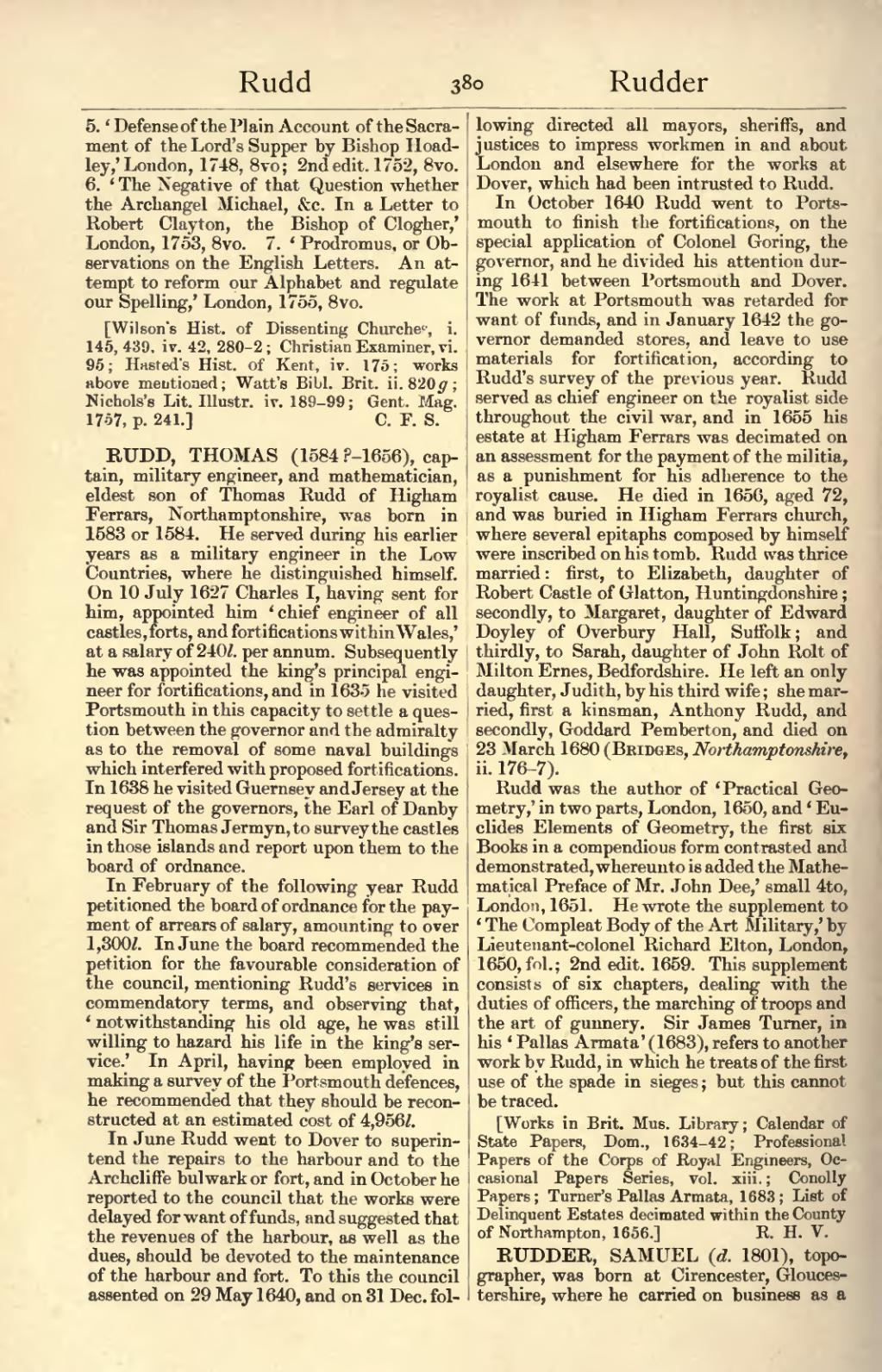- ‘Defense of the Plain Account of the Sacrament of the Lord's Supper by Bishop Hoadley,’ London, 1748, 8vo; 2nd edit. 1752, 8vo.
- ‘The Negative of that Question whether the Archangel Michael, &c. In a Letter to Robert Clayton, the Bishop of Clogher,’ London, 1753, 8vo.
- ‘Prodromus, or Observations on the English Letters. An attempt to reform our Alphabet and regulate our Spelling,’ London, 1755, 8vo.
[Wilson's Hist. of Dissenting Churches, i. 145, 439, iv. 42, 280–2; Christian Examiner, vi. 95; Hasted's Hist. of Kent, iv. 175; works above mentioned; Watt's Bibl. Brit. ii. 820 g; Nichols's Lit. Illustr. iv. 189–99; Gent. Mag. 1757, p. 241.]
RUDD, THOMAS (1584?–1656), captain, military engineer, and mathematician, eldest son of Thomas Rudd of Higham Ferrars, Northamptonshire, was born in 1583 or 1584. He served during his earlier years as a military engineer in the Low Countries, where he distinguished himself. On 10 July 1627 Charles I, having sent for him, appointed him ‘chief engineer of all castles, forts, and fortifications within Wales,’ at a salary of 240l. per annum. Subsequently he was appointed the king's principal engineer for fortifications, and in 1635 he visited Portsmouth in this capacity to settle a question between the governor and the admiralty as to the removal of some naval buildings which interfered with proposed fortifications. In 1638 he visited Guernsey and Jersey at the request of the governors, the Earl of Danby and Sir Thomas Jermyn, to survey the castles in those islands and report upon them to the board of ordnance.
In February of the following year Rudd petitioned the board of ordnance for the payment of arrears of salary, amounting to over 1,300l. In June the board recommended the petition for the favourable consideration of the council, mentioning Rudd's services in commendatory terms, and observing that, ‘notwithstanding his old age, he was still willing to hazard his life in the king's service.’ In April, having been employed in making a survey of the Portsmouth defences, he recommended that they should be reconstructed at an estimated cost of 4,956l.
In June Rudd went to Dover to superintend the repairs to the harbour and to the Archcliffe bulwark or fort, and in October he reported to the council that the works were delayed for want of funds, and suggested that the revenues of the harbour, as well as the dues, should be devoted to the maintenance of the harbour and fort. To this the council assented on 29 May 1640, and on 31 Dec. following directed all mayors, sheriffs, and justices to impress workmen in and about London and elsewhere for the works at Dover, which had been intrusted to Rudd.
In October 1640 Rudd went to Portsmouth to finish the fortifications, on the special application of Colonel Goring, the governor, and he divided his attention during 1641 between Portsmouth and Dover. The work at Portsmouth was retarded for want of funds, and in January 1642 the governor demanded stores, and leave to use materials for fortification, according to Rudd's survey of the previous year. Rudd served as chief engineer on the royalist side throughout the civil war, and in 1655 his estate at Higham Ferrars was decimated on an assessment for the payment of the militia, as a punishment for his adherence to the royalist cause. He died in 1656, aged 72, and was buried in Higham Ferrars church, where several epitaphs composed by himself were inscribed on his tomb. Rudd was thrice married: first, to Elizabeth, daughter of Robert Castle of Glatton, Huntingdonshire; secondly, to Margaret, daughter of Edward Doyley of Overbury Hall, Suffolk; and thirdly, to Sarah, daughter of John Rolt of Milton Ernes, Bedfordshire. He left an only daughter, Judith, by his third wife; she married, first a kinsman, Anthony Rudd, and secondly, Goddard Pemberton, and died on 23 March 1680 (Bridges, Northamptonshire, ii. 176–7).
Rudd was the author of ‘Practical Geometry,’ in two parts, London, 1650, and ‘Euclides Elements of Geometry, the first six Books in a compendious form contrasted and demonstrated, whereunto is added the Mathematical Preface of Mr. John Dee,’ small 4to, London, 1651. He wrote the supplement to ‘The Compleat Body of the Art Military,’ by Lieutenant-colonel Richard Elton, London, 1650, fol.; 2nd edit. 1659. This supplement consists of six chapters, dealing with the duties of officers, the marching of troops and the art of gunnery. Sir James Turner, in his ‘Pallas Armata’ (1683), refers to another work by Rudd, in which he treats of the first use of the spade in sieges; but this cannot be traced.
[Works in Brit. Mus. Library; Calendar of State Papers, Dom., 1634–42; Professional Papers of the Corps of Royal Engineers, Occasional Papers Series, vol. xiii.; Conolly Papers; Turner's Pallas Armata, 1683; List of Delinquent Estates decimated within the County of Northampton, 1656.]
RUDDER, SAMUEL (d. 1801), topographer, was born at Cirencester, Gloucestershire, where he carried on business as a
